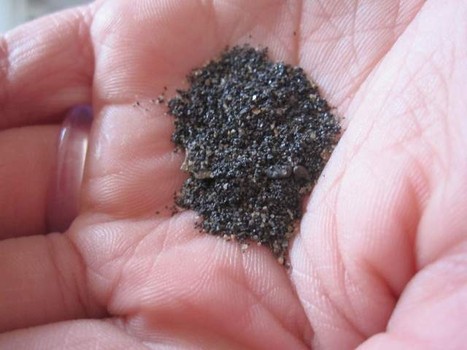 Last week, my husband took our kids to a local lake to look for meteorites. Yes, meteorites!
Last week, my husband took our kids to a local lake to look for meteorites. Yes, meteorites!
Okay, they were micrometeorites to be more specific, but nonetheless, the kids were able to find and hold something that came from millions of miles away in space. Can you think of a cooler way to spend a Wednesday afternoon?! 🙂
What’s a micrometeorite and why are they on the beach?
As meteorite expert John Beauford says:
Pieces of rock and metal frequently collide with Earth’s upper atmosphere. Most of these are no bigger than a golf ball but are traveling at tens of thousands of kilometers per hour. The atmosphere is very thin at this altitude of 80 to 100 kilometers (50 to 62 miles), however, it creates enough friction to cause these travelers from space to heat up to temperatures that make them burn brightly. These are the fireballs in the sky that are rightly called meteors, although they are often referred to as “shooting stars.”
Most meteors burn up completely in the atmosphere and never reach the ground. Those that survive the trip and reach the surface of Earth are called meteorites. While it is generally believed that meteorites are fairly rare, in reality about 30,000 tons of extraterrestrial material are deposited on Earth each year; bits of comets, chunks of asteroids, debris from the formation of our solar system more than four billion years ago. So why aren’t meteorites seen more often sitting on the ground? First of all, the largest portion of this material falls into the oceans, and secondly, most of the material that reaches the surface is microscopic, much too small to be noticed. These are the tiny specimens known as micrometeorites. As tons of micrometeorites fall each year, they gently land in our fields, on our homes, and on us.
There are lots of experiments online that recommend using rainfall, rooftops and visits to Antarctica to collect micrometeorites. Many involve waiting weeks (or an awfully long field trip). Since we’re sort of an impatient family, we wanted to do something that would require a little less time and effort. Our way is not quite as scientific as an expedition to Antarctica, but it is a great way to spark excitement about science.
And it involves hanging out at the lake, which is pretty nice too.
Here’s how our family did it…
What they needed:
They used a large magnet “pick up tool” like this one but any strong magnet will do. This type is nice because you can pull the handle to release the magnetic pull. They also used a plastic sandwich bag, a string and a piece of white paper.
What they did:
They took the magnet, tied a string on the handle, and walked along, swinging the magnet just barely over the sand (and sometimes dragging it through it). After about 10 feet, they’d go to the shore where they had a piece of printer paper on the ground. They’d hold the magnet over the paper and pull the release, so the particles fell on the paper (sometimes they had to scrape them off the side as well). Once it was all on the paper, they’d fold it to make a pour spout and put it in a collecting bag.
If you don’t have a pull-release magnet, simply put a strong magnet in a sandwich bag and proceed the same way. When you want to release the magnetic grains, simply hold the magnet in the bag over the paper and withdraw the magnet from the bag. The particles will then fall to the paper.
Why it works:
Minnesota is certainly not the best place to find a meteorite, since those are most easily found in dry, desert regions. That said, tens of thousands of tons of meteorite dust fall every year all over the earth. These particles fall everywhere — even in our back yards and at our lakes. Meteorites contain iron, which is magnetic. Earth rocks are not magnetic, though they can contain magnetic particles (and other particles you can find will be magnetic too, of course).
There are detractors out there who tell you that this type of experiment won’t get only micrometeorites because other magnetic particles are out there, particularly from industrial pollution. That may be, and you can explain to the children that some of the magnetic particles will probably not be micrometeorites. But the fact is that some of them are, and that sort of fact is exactly the sort of fact that gets children really excited about astonomy.
Who’s going to get in the way of that?
Furthermore, this is a great dilemma to discuss with the children. Talk about how you might be able to tell the difference. Could you tell by looking at the particles under a microscope? Micrometeorites are supposed to be cyllindrical from their fall through the atmosphere. Some of the other types of magnetic particles would be and others would not. Are there any tests you could perform or other ways to identify the real micrometeorites from the imposters?
The book We Dare You (the Kindle version is only $1.99) talks about how to find meteorites at the beach (with similar instructions) and also gives instructions on how to harvest micrometeorites from rainwater in gutters if you’re not near a beach. You can read the instructions for both here.
***
This article originally appeared on examiner.com.
This post contains affiliate links. Thanks for your support!




